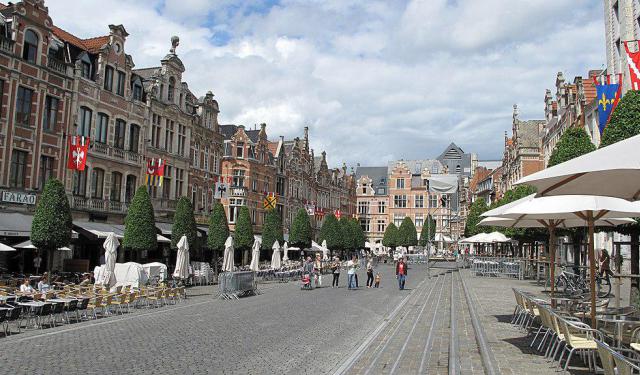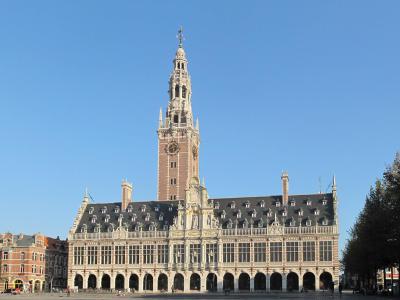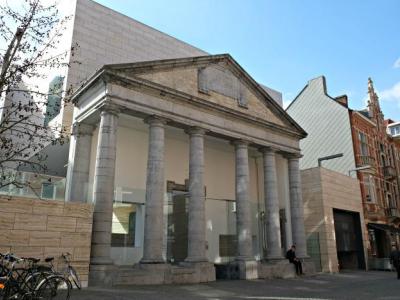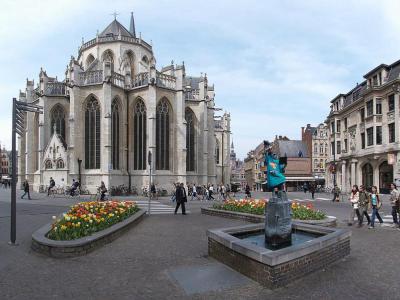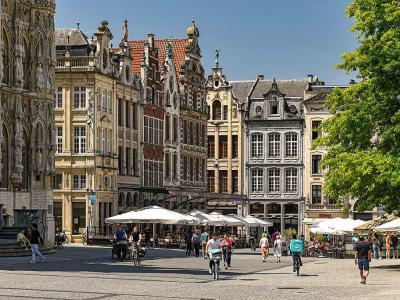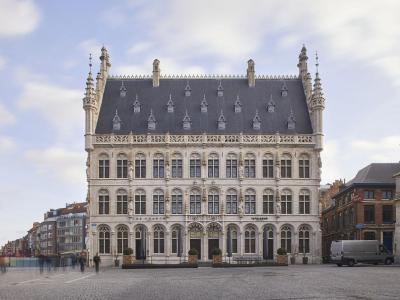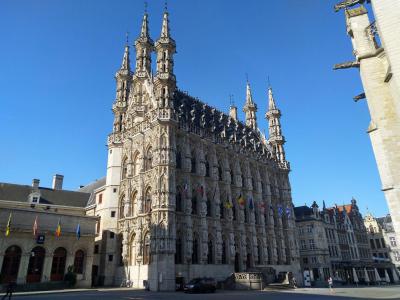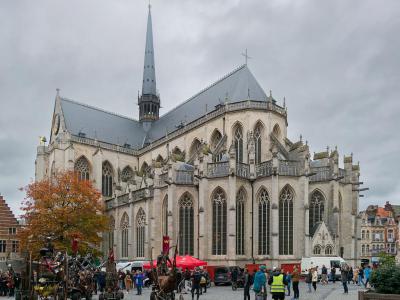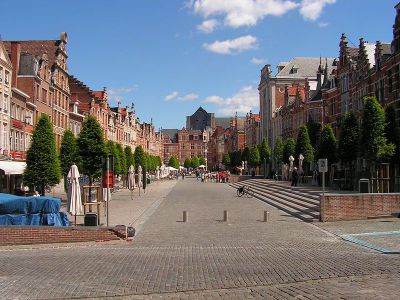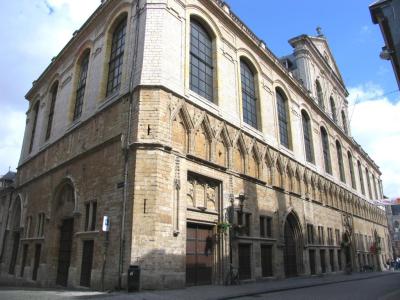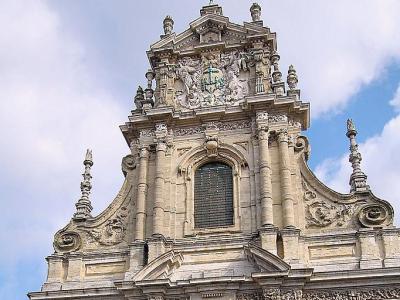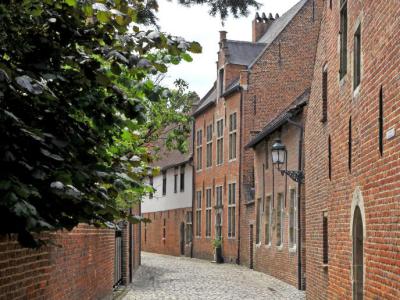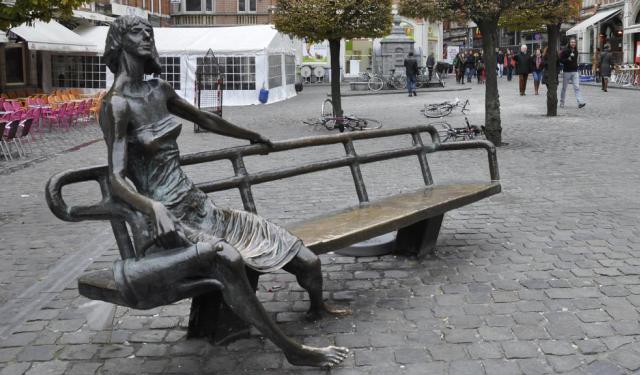Leuven Introduction Walking Tour (Self Guided), Leuven
Nestled in the heart of Belgium, the picturesque town of Leuven has no shortage of historic and cultural attractions. Its name is thought to originate from the Old Germanic word "Loven," meaning “to love or praise”, an explanation of which may be found in the Leuven slogan, “Always praise God.”
Leuven's roots date back to 891 when it was first mentioned after a Viking army was defeated by the Frankish king Arnulf. According to legend, its red and white arms symbolize bloodshed during the battle.
The city gained prominence as a center of learning with the establishment of the University of Leuven, one of the oldest universities in the world, in 1425. Notable landmarks like the Town Hall and Saint Peter's Church were also built during that time. Leuven became a hub for Renaissance art, nurturing painting talents like Dirk Bouts and Quinten Metsys. Humanist thinkers such as Erasmus thrived in its intellectual atmosphere, leading to innovations in education and literature. Despite periods of religious persecution and political upheaval, Leuven's academic legacy endured, influencing scholars like Thomas More and shaping disciplines like mathematics and astronomy.
In the 18th century, thanks to its brewing industry, notably the Stella Artois variety, the city gained international fame. In the 19th century, Leuven saw significant development with gas lighting and urban renovations.
In addition to numerous sieges and foreign occupations endured throughout history, the 20th century brought further devastation to Leuven, with both World Wars leaving significant scars. During World War I, the city suffered extensive damage, seeing its iconic University Library razed to the ground in 1914. Although reconstructed and reopened in 1928, the library was once again set on fire during World War II, losing nearly a million books. After the war, the city had to be almost completely reconstructed and ancient buildings carefully restored according to old drawings.
Today, no visit to Leuven is complete without exploring its historic squares, primarily the Great Market Square (Grote Markt) lined with colorful facades and lively cafes. The Old Market Square (Oude Markt) is another must-visit destination, affectionately nicknamed the "longest bar in the world" for its array of bars and restaurants.
Among Leuven's architectural marvels is the Great Beguinage, a UNESCO World Heritage site that once served as a communal living space for religious women.
These and other locations of note await those who seek to immerse themselves in the charm of this Belgian city. So, plan your visit today and rely on our self-guided tour to discover the enchanting allure of this cultural gem.
Leuven's roots date back to 891 when it was first mentioned after a Viking army was defeated by the Frankish king Arnulf. According to legend, its red and white arms symbolize bloodshed during the battle.
The city gained prominence as a center of learning with the establishment of the University of Leuven, one of the oldest universities in the world, in 1425. Notable landmarks like the Town Hall and Saint Peter's Church were also built during that time. Leuven became a hub for Renaissance art, nurturing painting talents like Dirk Bouts and Quinten Metsys. Humanist thinkers such as Erasmus thrived in its intellectual atmosphere, leading to innovations in education and literature. Despite periods of religious persecution and political upheaval, Leuven's academic legacy endured, influencing scholars like Thomas More and shaping disciplines like mathematics and astronomy.
In the 18th century, thanks to its brewing industry, notably the Stella Artois variety, the city gained international fame. In the 19th century, Leuven saw significant development with gas lighting and urban renovations.
In addition to numerous sieges and foreign occupations endured throughout history, the 20th century brought further devastation to Leuven, with both World Wars leaving significant scars. During World War I, the city suffered extensive damage, seeing its iconic University Library razed to the ground in 1914. Although reconstructed and reopened in 1928, the library was once again set on fire during World War II, losing nearly a million books. After the war, the city had to be almost completely reconstructed and ancient buildings carefully restored according to old drawings.
Today, no visit to Leuven is complete without exploring its historic squares, primarily the Great Market Square (Grote Markt) lined with colorful facades and lively cafes. The Old Market Square (Oude Markt) is another must-visit destination, affectionately nicknamed the "longest bar in the world" for its array of bars and restaurants.
Among Leuven's architectural marvels is the Great Beguinage, a UNESCO World Heritage site that once served as a communal living space for religious women.
These and other locations of note await those who seek to immerse themselves in the charm of this Belgian city. So, plan your visit today and rely on our self-guided tour to discover the enchanting allure of this cultural gem.
How it works: Download the app "GPSmyCity: Walks in 1K+ Cities" from Apple App Store or Google Play Store to your mobile phone or tablet. The app turns your mobile device into a personal tour guide and its built-in GPS navigation functions guide you from one tour stop to next. The app works offline, so no data plan is needed when traveling abroad.
Leuven Introduction Walking Tour Map
Guide Name: Leuven Introduction Walking Tour
Guide Location: Belgium » Leuven (See other walking tours in Leuven)
Guide Type: Self-guided Walking Tour (Sightseeing)
# of Attractions: 11
Tour Duration: 1 Hour(s)
Travel Distance: 1.6 Km or 1 Miles
Author: karenl
Sight(s) Featured in This Guide:
Guide Location: Belgium » Leuven (See other walking tours in Leuven)
Guide Type: Self-guided Walking Tour (Sightseeing)
# of Attractions: 11
Tour Duration: 1 Hour(s)
Travel Distance: 1.6 Km or 1 Miles
Author: karenl
Sight(s) Featured in This Guide:
- University Library and Bell Tower
- Museum M
- Rector De Somerplein Square
- Great Market Square (Grote Markt)
- Tafelrond (Round Table)
- Town Hall
- Saint Peter’s Church
- Oude Markt (Old Market Square)
- KU Leuven (Catholic University of Leuven)
- Saint Michael’s Church
- Great Beguinage
1) University Library and Bell Tower (must see)
Designed by the visionary American architect Whitney Warren in a neo-Flemish-Renaissance style, the University Library was erected between 1921 and 1928. Its grandiose dimensions, a testament to Allied victory against Germany, establish it as one of the city's most monumental university edifices.
Tragically, in 1940, amidst the tumult of the second German invasion of Leuven, the University Library fell victim to a devastating fire, resulting in the loss of its priceless collection comprising 900,000 manuscripts and books. The inferno, believed to have ignited during an exchange of hostilities between the warring forces rather than a deliberate act, inflicted irreparable damage upon the cultural heritage housed within its walls.
Following the ravages of war, the University Library was painstakingly reconstructed in accordance with Warren's original design, serving as a poignant testament to resilience and the enduring pursuit of knowledge. The rebuilding effort, buoyed by generous contributions from around the globe, reaffirmed the library's significance as a custodian of learning and cultural exchange.
Today, the University Library and its accompanying Bell Tower offers visitors a captivating journey through history and a breathtaking panoramic view of the city. As you ascend the tower, you are immersed in a permanent exhibition that chronicles the stirring history of the University Library and its iconic carillon tower. Delve into the rich tapestry of Leuven's past, from the triumphs of academia to the challenges of war and reconstruction. Discover the architectural marvels and cultural significance of this historic landmark, whose story is woven into the fabric of the city's identity.
Tragically, in 1940, amidst the tumult of the second German invasion of Leuven, the University Library fell victim to a devastating fire, resulting in the loss of its priceless collection comprising 900,000 manuscripts and books. The inferno, believed to have ignited during an exchange of hostilities between the warring forces rather than a deliberate act, inflicted irreparable damage upon the cultural heritage housed within its walls.
Following the ravages of war, the University Library was painstakingly reconstructed in accordance with Warren's original design, serving as a poignant testament to resilience and the enduring pursuit of knowledge. The rebuilding effort, buoyed by generous contributions from around the globe, reaffirmed the library's significance as a custodian of learning and cultural exchange.
Today, the University Library and its accompanying Bell Tower offers visitors a captivating journey through history and a breathtaking panoramic view of the city. As you ascend the tower, you are immersed in a permanent exhibition that chronicles the stirring history of the University Library and its iconic carillon tower. Delve into the rich tapestry of Leuven's past, from the triumphs of academia to the challenges of war and reconstruction. Discover the architectural marvels and cultural significance of this historic landmark, whose story is woven into the fabric of the city's identity.
2) Museum M
Showcasing a captivating blend of old and new art inspired by Leuven's versatility, the Museum M offers visitors a journey through the region's artistic evolution from the Middle Ages to the 19th century. The collection primarily focuses on art production in Leuven and Brabant, featuring works by renowned artists such as Constantin Meunier, Jef Lambeaux, and Georges Minne. Through a curated selection of paintings, sculptures, and other artistic creations, Museum M provides insight into the vibrant artistic traditions that have shaped the identity of Leuven and its surrounding region over the centuries.
In addition to its impressive permanent collection, Museum M presents a dynamic array of temporary exhibitions, showcasing both old masters and contemporary artists. These exhibitions offer visitors the opportunity to explore diverse artistic expressions and gain a deeper understanding of the evolving art scene in Leuven. Whether you're drawn to classical masterpieces or contemporary innovations, Museum M's ever-changing exhibitions promise to inspire and captivate art enthusiasts of all ages.
Beyond its rich artistic offerings, Museum M is renowned for its striking architecture, designed by the esteemed Belgian architect Stéphane Beel. Integrating historical buildings with contemporary design elements, the museum complex is a masterpiece of architectural innovation. Visitors are invited to explore the museum's enclosed garden and rooftop terrace, offering stunning views of the surrounding cityscape.
In addition to its impressive permanent collection, Museum M presents a dynamic array of temporary exhibitions, showcasing both old masters and contemporary artists. These exhibitions offer visitors the opportunity to explore diverse artistic expressions and gain a deeper understanding of the evolving art scene in Leuven. Whether you're drawn to classical masterpieces or contemporary innovations, Museum M's ever-changing exhibitions promise to inspire and captivate art enthusiasts of all ages.
Beyond its rich artistic offerings, Museum M is renowned for its striking architecture, designed by the esteemed Belgian architect Stéphane Beel. Integrating historical buildings with contemporary design elements, the museum complex is a masterpiece of architectural innovation. Visitors are invited to explore the museum's enclosed garden and rooftop terrace, offering stunning views of the surrounding cityscape.
3) Rector De Somerplein Square
Situated near the choir of the Sint-Pieterskerk, Rector De Somerplein Squaree occupies the former site of Leuven's Hay Market, which once served as a bustling hub connecting three major streets. However, the area underwent a dramatic transformation in the aftermath of the Great Fire of Leuven in August 1914, when German troops laid waste to the city center. To rejuvenate the devastated space, it was converted into a green zone and eventually developed into Rector De Somerplein in 1925.
Originally named Maarschalk Fochplein after the French Marshal Ferdinand Foch, the square was redesigned in 1975 to coincide with the 550-year anniversary of Leuven University. At its heart stands a water fountain adorned with a bronze statue known as Source of Wisdom, sculpted by J. Claerhout. Affectionately referred to as 'Fonske' by locals, the statue depicts a student engrossed in reading an open book, with a glass continuously pouring water into his open head. While the imagery may seem somewhat macabre, university students humorously interpret the never-ending glass as a beer glass, humorously claiming it as their source of wisdom.
In 2011, the square was renamed Rector De Somerplein in honor of Pieter De Somer, the first rector of the new Dutch-language Catholic University in Leuven. Today, Rector De Somerplein Square serves as a vibrant public space, inviting locals and visitors alike to gather, relax, and admire the iconic Fonske statue while reflecting on the city's rich academic heritage and enduring spirit of resilience.
Originally named Maarschalk Fochplein after the French Marshal Ferdinand Foch, the square was redesigned in 1975 to coincide with the 550-year anniversary of Leuven University. At its heart stands a water fountain adorned with a bronze statue known as Source of Wisdom, sculpted by J. Claerhout. Affectionately referred to as 'Fonske' by locals, the statue depicts a student engrossed in reading an open book, with a glass continuously pouring water into his open head. While the imagery may seem somewhat macabre, university students humorously interpret the never-ending glass as a beer glass, humorously claiming it as their source of wisdom.
In 2011, the square was renamed Rector De Somerplein in honor of Pieter De Somer, the first rector of the new Dutch-language Catholic University in Leuven. Today, Rector De Somerplein Square serves as a vibrant public space, inviting locals and visitors alike to gather, relax, and admire the iconic Fonske statue while reflecting on the city's rich academic heritage and enduring spirit of resilience.
4) Great Market Square (Grote Markt) (must see)
The Great Market Square strategic location at the intersection of some of the city's most famous landmarks makes it a focal point for locals and tourists alike. Despite its vibrant atmosphere, the square has been pedestrian-friendly for several years, with only public transportation buses from De Lijn permitted to traverse its grounds.
Dating back to the 14th century, the Great Market Square has retained much of its original charm and architectural splendor. Its layout has remained largely unchanged since the establishment of the Catholic University Leuven. The square is adorned with Gothic-style buildings, with the town hall serving as a prominent example of this architectural heritage. Alongside the town hall, visitors can marvel at the Church of Saint Peter and several guild houses, each contributing to the square's rich historical tapestry.
In addition to its architectural marvels, the Great Market Square boasts a vibrant social scene, with numerous pubs, taverns, and eateries dotting its perimeter. Here, visitors can experience a blend of formal and traditional establishments alongside trendy, youth-oriented venues. This juxtaposition of styles creates a dynamic atmosphere, catering to a diverse range of tastes and preferences.
Dating back to the 14th century, the Great Market Square has retained much of its original charm and architectural splendor. Its layout has remained largely unchanged since the establishment of the Catholic University Leuven. The square is adorned with Gothic-style buildings, with the town hall serving as a prominent example of this architectural heritage. Alongside the town hall, visitors can marvel at the Church of Saint Peter and several guild houses, each contributing to the square's rich historical tapestry.
In addition to its architectural marvels, the Great Market Square boasts a vibrant social scene, with numerous pubs, taverns, and eateries dotting its perimeter. Here, visitors can experience a blend of formal and traditional establishments alongside trendy, youth-oriented venues. This juxtaposition of styles creates a dynamic atmosphere, catering to a diverse range of tastes and preferences.
5) Tafelrond (Round Table)
Dating back to 1817, the Round Table stands as the third most important building on the Main Market square, a central hub of the city since the 15th century. Originally serving as a meeting place for various guilds in Leuven, the Round Table bore witness to lively gatherings of the Rhetoricians, who congregated to recite poetry and engage in conviviality.
Throughout its storied history, the Round Table has undergone transformations reflective of the city's evolving cultural landscape. Following its demolition and subsequent reconstruction, the building experienced a revival in 1817, becoming a hub for music and theater. However, its resilience was put to the test during the First World War when it fell victim to bombings and destruction. In the aftermath of the war, the Round Table was painstakingly rebuilt in its original Gothic style by architect de Layens, restoring its former grandeur. In its post-war incarnation, the Round Table took on new roles, serving as the Leuven branch of the National Bank from 1930 onwards.
Today, the Round Table enters its fourth chapter, reborn as the Tafelrond Hotel, blending its rich heritage with modern amenities and technology. The hotel offers guests a unique experience, immersing them in the lyrical stories embedded within its walls while embracing the spirit of innovation and contemporary hospitality.
Throughout its storied history, the Round Table has undergone transformations reflective of the city's evolving cultural landscape. Following its demolition and subsequent reconstruction, the building experienced a revival in 1817, becoming a hub for music and theater. However, its resilience was put to the test during the First World War when it fell victim to bombings and destruction. In the aftermath of the war, the Round Table was painstakingly rebuilt in its original Gothic style by architect de Layens, restoring its former grandeur. In its post-war incarnation, the Round Table took on new roles, serving as the Leuven branch of the National Bank from 1930 onwards.
Today, the Round Table enters its fourth chapter, reborn as the Tafelrond Hotel, blending its rich heritage with modern amenities and technology. The hotel offers guests a unique experience, immersing them in the lyrical stories embedded within its walls while embracing the spirit of innovation and contemporary hospitality.
6) Town Hall (must see)
The Town Hall stands as a magnificent example of Gothic architecture and civic pride. Originally part of a larger complex of municipal buildings, construction on the building, known then as the Voirste Huys or "front house," commenced in 1439. Situated at the site of an existing town hall, the structure has since become an iconic symbol of Leuven's rich history and heritage.
Characterized by its striking design, the Town Hall boasts three main stories adorned with pointed Gothic windows, providing a glimpse into the architectural style prevalent during its construction period. Above, a gallery parapet adds to the building's grandeur, leading to a steep roof punctuated by four tiers of dormers. Octagonal turrets situated at the roof's angles feature slits that allow for the passage of light, enhancing the building's aesthetic appeal and functionality.
The main façade of the Town Hall is equally impressive, featuring an entrance staircase and two central portals adorned with intricate carvings. Atop these portals stand figures of Saint Peter and the Madonna and Child, paying homage to the patron saint of the nearby church. Beyond its architectural splendor, the Town Hall's interior houses a captivating collection of artwork, including sculptures by renowned artists Constantin Meunier and Jef Lambeaux. Additionally, visitors can explore portraits of Leuven mayors dating back to 1794, providing insight into the city's governance and leadership over the centuries.
Characterized by its striking design, the Town Hall boasts three main stories adorned with pointed Gothic windows, providing a glimpse into the architectural style prevalent during its construction period. Above, a gallery parapet adds to the building's grandeur, leading to a steep roof punctuated by four tiers of dormers. Octagonal turrets situated at the roof's angles feature slits that allow for the passage of light, enhancing the building's aesthetic appeal and functionality.
The main façade of the Town Hall is equally impressive, featuring an entrance staircase and two central portals adorned with intricate carvings. Atop these portals stand figures of Saint Peter and the Madonna and Child, paying homage to the patron saint of the nearby church. Beyond its architectural splendor, the Town Hall's interior houses a captivating collection of artwork, including sculptures by renowned artists Constantin Meunier and Jef Lambeaux. Additionally, visitors can explore portraits of Leuven mayors dating back to 1794, providing insight into the city's governance and leadership over the centuries.
7) Saint Peter’s Church (must see)
With roots dating back to 986, Saint Peter’s Church ranks among the oldest churches in Leuven. However, its original structure succumbed to flames in 1776, paving the way for the construction of the present-day edifice. The current building, erected shortly thereafter, emerged as a grander and more expansive testament to the town's devout community. In recognition of its historical and architectural importance, Saint Peter’s Church, along with its belfry, was designated as a UNESCO World Heritage site in 1999.
Within the hallowed walls of Saint Peter’s Church, visitors are treated to a rich tapestry of artistic treasures and religious artifacts. One of its most celebrated works is ‘The Last Supper’ by Dieric Bouts, a masterpiece of Flemish Primitive artistry. Painted nearly 600 years ago, this iconic artwork adorns the church's chapel, captivating viewers with its timeless beauty and spiritual resonance. Additionally, Bouts' ‘The Martyrdom of Saint Erasmus’ and the 'Edelheere Triptych' further enrich the church's artistic legacy, offering glimpses into the rich cultural heritage of Leuven.
Innovative technology enhances the visitor experience at Saint Peter’s Church, with the introduction of mixed reality through hololens. This cutting-edge technology allows visitors to immerse themselves in a world where art comes to life. By donning the hololens, viewers can witness spectacular 3D images and animations overlaid onto the physical environment, offering a unique perspective on the church's masterpieces.
Within the hallowed walls of Saint Peter’s Church, visitors are treated to a rich tapestry of artistic treasures and religious artifacts. One of its most celebrated works is ‘The Last Supper’ by Dieric Bouts, a masterpiece of Flemish Primitive artistry. Painted nearly 600 years ago, this iconic artwork adorns the church's chapel, captivating viewers with its timeless beauty and spiritual resonance. Additionally, Bouts' ‘The Martyrdom of Saint Erasmus’ and the 'Edelheere Triptych' further enrich the church's artistic legacy, offering glimpses into the rich cultural heritage of Leuven.
Innovative technology enhances the visitor experience at Saint Peter’s Church, with the introduction of mixed reality through hololens. This cutting-edge technology allows visitors to immerse themselves in a world where art comes to life. By donning the hololens, viewers can witness spectacular 3D images and animations overlaid onto the physical environment, offering a unique perspective on the church's masterpieces.
8) Oude Markt (Old Market Square) (must see)
The Old Market Square holds a special place in the heart of the vibrant student city, earning its affectionate nickname as the "longest bar in the world" among locals and students alike. Dating back to 1150, this historic square served as the city's primary marketplace, bustling with activity long before the construction of the newer market square in the 15th century. Despite its unofficial title, the Old Market Square remains the focal point of social gatherings and nightlife in Leuven.
Spanning an impressive 174 meters in length and 34 meters in width, the Old Market Square boasts a rich history intertwined with the city's cultural heritage. However, the square faced adversity during the onset of the First World War in 1914 when the houses lining its perimeter were ravaged by fire. Despite the destruction, the resilient spirit of Leuven prevailed, and the square was meticulously restored to its former glory in the aftermath of the war.
Today, a visit to the Old Market Square offers a quintessential Leuven experience, reminiscent of pulling up a chair at Europe's longest bar. With an array of catering establishments dotting the square, ranging from cozy cafes to lively pubs and trendy bars, the Old Market Square exudes a dynamic atmosphere that captivates visitors day and night. Particularly during warm weather, the numerous terraces lining the square quickly fill up, making it the preferred gathering spot for locals and visitors seeking to immerse themselves in Leuven's vibrant social scene.
Spanning an impressive 174 meters in length and 34 meters in width, the Old Market Square boasts a rich history intertwined with the city's cultural heritage. However, the square faced adversity during the onset of the First World War in 1914 when the houses lining its perimeter were ravaged by fire. Despite the destruction, the resilient spirit of Leuven prevailed, and the square was meticulously restored to its former glory in the aftermath of the war.
Today, a visit to the Old Market Square offers a quintessential Leuven experience, reminiscent of pulling up a chair at Europe's longest bar. With an array of catering establishments dotting the square, ranging from cozy cafes to lively pubs and trendy bars, the Old Market Square exudes a dynamic atmosphere that captivates visitors day and night. Particularly during warm weather, the numerous terraces lining the square quickly fill up, making it the preferred gathering spot for locals and visitors seeking to immerse themselves in Leuven's vibrant social scene.
9) KU Leuven (Catholic University of Leuven)
The Catholic University of Leuven stands as a prestigious institution of higher learning with a rich history dating back to its founding in 1425 Established by Pope Martin V at the request of Duke John IV of Brabant, the university was modeled after the esteemed University of Paris. For centuries, it served as a unitary entity until 1970 when it underwent partitioning, driven by linguistic differences, resulting in the creation of two separate universities.
Following student riots, ethnic protests, and government upheavals in 1969, the Catholic University underwent significant reorganization, leading to the establishment of separate Flemish- and French-language divisions. This pivotal moment marked the beginning of distinct legal statuses for each division, with the first faculties being established in Louvain-la-Neuve in 1972.
The university's historical significance is intertwined with the Cloth Hall, originally used by weavers for selling cloth. Following the university's establishment, part of the building was allocated as classroom space. Tragically, during the German occupation in 1914, the Cloth Hall suffered extensive damage in the Great Fire of Leuven, resulting in the loss of 300,000 books and manuscripts. However, the resilient spirit of the university prevailed, leading to the rebuilding of the library at Ladeuzeplein.
Today, the Cloth Hall serves as the university's policy center and remains a central hub for enrollment, while also housing a museum, university shop, and a cozy coffee bar, welcoming visitors to explore its historical significance and academic legacy.
Following student riots, ethnic protests, and government upheavals in 1969, the Catholic University underwent significant reorganization, leading to the establishment of separate Flemish- and French-language divisions. This pivotal moment marked the beginning of distinct legal statuses for each division, with the first faculties being established in Louvain-la-Neuve in 1972.
The university's historical significance is intertwined with the Cloth Hall, originally used by weavers for selling cloth. Following the university's establishment, part of the building was allocated as classroom space. Tragically, during the German occupation in 1914, the Cloth Hall suffered extensive damage in the Great Fire of Leuven, resulting in the loss of 300,000 books and manuscripts. However, the resilient spirit of the university prevailed, leading to the rebuilding of the library at Ladeuzeplein.
Today, the Cloth Hall serves as the university's policy center and remains a central hub for enrollment, while also housing a museum, university shop, and a cozy coffee bar, welcoming visitors to explore its historical significance and academic legacy.
10) Saint Michael’s Church
Constructed between 1650 and 1671 under the guidance of Jesuit architect Willem Hesius, Saint Michael's Church was initially intended as a place of worship for the Jesuit College of Leuven. The Jesuit community, founded by Ignatius de Loyola in Paris in 1540, found its way to Leuven in 1542, where it established its presence and began laying the foundation for Saint Michael's Church.
Reflecting the grandeur of Baroque architecture, Saint Michael's Church is often regarded as a masterpiece of the Jesuit style. Drawing inspiration from the illustrious Il Gesù Baroque Church in Rome, the church stands as a testament to the artistic and spiritual prowess of its creators. Despite its intended dome remaining unfinished, the church's facade stands as one of the renowned "seven wonders of Leuven," adorned with intricate decorations and ornate detailing that captivate the eye of beholders.
Rich in historical artifacts and original Baroque furnishings, such as the copper holy-water font dating back to 1473 and the frontal facade resembling an altar, the church offers visitors a glimpse into its storied past and architectural splendor.
Today, Saint Michael's Church continues to stand as a symbol of faith and cultural heritage, welcoming visitors from near and far to marvel at its awe-inspiring beauty and immerse themselves in its rich history.
Reflecting the grandeur of Baroque architecture, Saint Michael's Church is often regarded as a masterpiece of the Jesuit style. Drawing inspiration from the illustrious Il Gesù Baroque Church in Rome, the church stands as a testament to the artistic and spiritual prowess of its creators. Despite its intended dome remaining unfinished, the church's facade stands as one of the renowned "seven wonders of Leuven," adorned with intricate decorations and ornate detailing that captivate the eye of beholders.
Rich in historical artifacts and original Baroque furnishings, such as the copper holy-water font dating back to 1473 and the frontal facade resembling an altar, the church offers visitors a glimpse into its storied past and architectural splendor.
Today, Saint Michael's Church continues to stand as a symbol of faith and cultural heritage, welcoming visitors from near and far to marvel at its awe-inspiring beauty and immerse themselves in its rich history.
11) Great Beguinage (must see)
The Great Beguinage of Leuven stands as a remarkable testament to medieval communal living and architectural heritage. Situated in the southern part of downtown Leuven, this historical quarter spans about 3 hectares (7.5 acres) and consists of a dozen streets lined with nearly 100 houses containing some 300 apartments. It ranks among the largest and best-preserved beguinages in the Low Countries, offering a glimpse into a bygone era of communal living.
Nestled along the banks of the river Dijle, the Great Beguinage is divided by the river into two parts, forming an island connected by three picturesque bridges. The entire beguinage, owned by the University of Leuven, serves as a campus, primarily housing students and academic guests. Stepping into the Great Beguinage feels like entering a small town, with its network of narrow streets, quaint squares, and charming houses.
The houses within the Great Beguinage, dating primarily from the period between 1630 and 1670, reflect the local traditional architecture enriched with subtle Baroque elements. Characterized by red brick facades adorned with sandstone cross-bar frames for windows and doors, these houses exude a timeless elegance. One of the distinctive features of the beguinage is the abundance of dormers, often embellished with crow-stepped gables and round arched windows, adding to its architectural charm and historical significance.
Nestled along the banks of the river Dijle, the Great Beguinage is divided by the river into two parts, forming an island connected by three picturesque bridges. The entire beguinage, owned by the University of Leuven, serves as a campus, primarily housing students and academic guests. Stepping into the Great Beguinage feels like entering a small town, with its network of narrow streets, quaint squares, and charming houses.
The houses within the Great Beguinage, dating primarily from the period between 1630 and 1670, reflect the local traditional architecture enriched with subtle Baroque elements. Characterized by red brick facades adorned with sandstone cross-bar frames for windows and doors, these houses exude a timeless elegance. One of the distinctive features of the beguinage is the abundance of dormers, often embellished with crow-stepped gables and round arched windows, adding to its architectural charm and historical significance.
Walking Tours in Leuven, Belgium
Create Your Own Walk in Leuven
Creating your own self-guided walk in Leuven is easy and fun. Choose the city attractions that you want to see and a walk route map will be created just for you. You can even set your hotel as the start point of the walk.
Leuven Monuments and Statues
Leuven, Belgium is a city steeped in history and culture, embellished with an assortment of monuments and statues that mirror its abundant heritage. Ranging from age-old landmarks to contemporary sculptures, each of them narrates a tale and contributes to the city's distinct allure. Whether paying tribute to historical luminaries, commemorating artistic triumphs, or simply enhancing the... view more
Tour Duration: 2 Hour(s)
Travel Distance: 2.4 Km or 1.5 Miles
Tour Duration: 2 Hour(s)
Travel Distance: 2.4 Km or 1.5 Miles
The Most Popular Cities
/ view all
